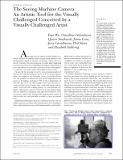| dc.contributor.author | Selvadurai, Chindhuri | |
| dc.contributor.author | Cavallerano, Jerry | |
| dc.contributor.author | Silver, Phil | |
| dc.contributor.author | Smithwick, Quinn Y. J. | |
| dc.contributor.author | Cain, James R. | |
| dc.contributor.author | Goldring, Elizabeth | |
| dc.contributor.author | Wu, Faye Y | |
| dc.date.accessioned | 2012-05-04T20:15:54Z | |
| dc.date.available | 2012-05-04T20:15:54Z | |
| dc.date.issued | 2012-02 | |
| dc.date.submitted | 2010-08 | |
| dc.identifier.issn | 0024-094X | |
| dc.identifier.issn | 1530-9282 | |
| dc.identifier.uri | http://hdl.handle.net/1721.1/70513 | |
| dc.description.abstract | The Vision Group at the Center for Advanced Visual Studies (CAVS) at the Massachusetts Institute of Technology (MIT) has developed the Seeing Machine Camera (SMC) under the direction of Elizabeth Goldring, a visually challenged artist. The SMC is an innovative tool that enables artistic expression for those with decreased vision. The camera enhances the ability to see the face of a loved one, look at a painting in a museum, photograph landscapes or create digital artwork. For visually challenged artists who may feel isolated from their visual world, the SMC provides an opportunity to connect to the people around them, enjoy a greater sense of independence and expand their creativity. | en_US |
| dc.language.iso | en_US | |
| dc.publisher | MIT Press | en_US |
| dc.relation.isversionof | http://dx.doi.org/10.1162/LEON_a_00280 | en_US |
| dc.rights | Article is made available in accordance with the publisher's policy and may be subject to US copyright law. Please refer to the publisher's site for terms of use. | en_US |
| dc.source | MIT Press | en_US |
| dc.title | The Seeing Machine Camera: An Artistic Tool for the Visually Challenged Conceived by a Visually Challenged Artist | en_US |
| dc.type | Article | en_US |
| dc.identifier.citation | Wu, Faye et al. “The Seeing Machine Camera: An Artistic Tool for the Visually Challenged Conceived by a Visually Challenged Artist.” Leonardo 45.2 (2012): 141–147. Web. 4 May 2012. © 2012 ISAST | en_US |
| dc.contributor.department | Massachusetts Institute of Technology. Computer Science and Artificial Intelligence Laboratory | en_US |
| dc.contributor.department | Massachusetts Institute of Technology. Department of Mechanical Engineering | en_US |
| dc.contributor.department | Massachusetts Institute of Technology. Media Laboratory | en_US |
| dc.contributor.department | Massachusetts Institute of Technology. Office of Educational Innovation and Technology | en_US |
| dc.contributor.department | Massachusetts Institute of Technology. Program in Art, Culture and Technology | en_US |
| dc.contributor.department | Massachusetts Institute of Technology. Robust Design Group | en_US |
| dc.contributor.approver | Smithwick, Quinn Y. J. | |
| dc.contributor.mitauthor | Wu, Faye Y. | |
| dc.contributor.mitauthor | Smithwick, Quinn Y. J. | |
| dc.contributor.mitauthor | Cain, James R. | |
| dc.contributor.mitauthor | Goldring, Elizabeth | |
| dc.relation.journal | Leonardo | en_US |
| dc.eprint.version | Final published version | en_US |
| dc.type.uri | http://purl.org/eprint/type/JournalArticle | en_US |
| eprint.status | http://purl.org/eprint/status/PeerReviewed | en_US |
| dspace.orderedauthors | Wu, Faye; Selvadurai, Chindhuri; Smithwick, Quinn; Cain, James; Cavallerano, Jerry; Silver, Phil; Goldring, Elizabeth | en |
| dc.identifier.orcid | https://orcid.org/0000-0002-8716-1039 | |
| dc.identifier.orcid | https://orcid.org/0000-0001-5950-1318 | |
| mit.license | PUBLISHER_POLICY | en_US |
| mit.metadata.status | Complete | |
